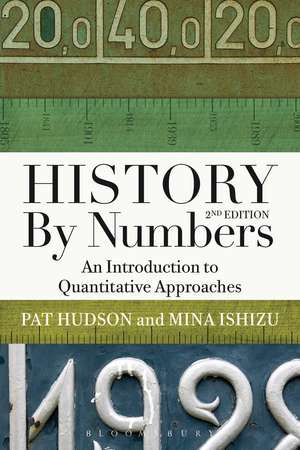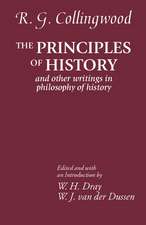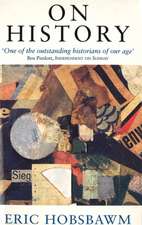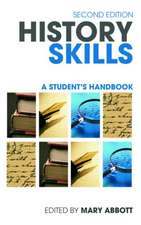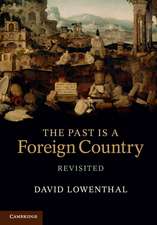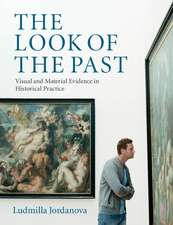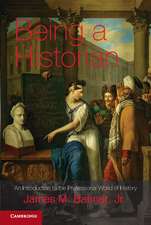History by Numbers: An Introduction to Quantitative Approaches
Autor Prof. Pat Hudson, Mina Ishizuen Limba Engleză Paperback – 16 noi 2016
| Toate formatele și edițiile | Preț | Express |
|---|---|---|
| Paperback (1) | 202.66 lei 22-36 zile | |
| Bloomsbury Publishing – 16 noi 2016 | 202.66 lei 22-36 zile | |
| Hardback (1) | 776.65 lei 43-57 zile | |
| Bloomsbury Publishing – 16 noi 2016 | 776.65 lei 43-57 zile |
Preț: 202.66 lei
Preț vechi: 233.13 lei
-13% Nou
Puncte Express: 304
Preț estimativ în valută:
38.78€ • 40.24$ • 32.42£
38.78€ • 40.24$ • 32.42£
Carte disponibilă
Livrare economică 24 februarie-10 martie
Preluare comenzi: 021 569.72.76
Specificații
ISBN-13: 9781849665377
ISBN-10: 1849665370
Pagini: 360
Dimensiuni: 156 x 234 x 19 mm
Greutate: 0.59 kg
Ediția:Revised
Editura: Bloomsbury Publishing
Colecția Bloomsbury Academic
Locul publicării:London, United Kingdom
ISBN-10: 1849665370
Pagini: 360
Dimensiuni: 156 x 234 x 19 mm
Greutate: 0.59 kg
Ediția:Revised
Editura: Bloomsbury Publishing
Colecția Bloomsbury Academic
Locul publicării:London, United Kingdom
Caracteristici
Its problem-solving approach introduces students to a wide range of statistical solutions in an accessible way
Notă biografică
Pat Hudson is Emeritus Professor of History at Cardiff University, UK.Mina Ishizu has recently held research fellowship posts in history at Manchester University and at the London School of Economics, UK.
Cuprins
Foreword1. The Prospects and Pitfalls of History by Numbers2. The Origins and Nature of Quantitative Thinking3. Arranging, Rearranging and Displaying Data4. Summarising Data: Averages and Distributions5. Time Series and Indices6. Relationships Between Variables7. Sampling and Significance Testing 8. Modelling History9. Computing, the Internet and HistoryGlossaryIndex
Recenzii
The chapters are structured clearly and accessibly; they also include useful exercises which are based on real research work ... A useful book, well-structured and with great pedagogical value.
History by Numbers is a perfect introduction to those unfamiliar with, or uncertain about, quantitative approaches to the study of the past. Written in an accessible and engaging style, even those who lack confidence with numbers, graphs and statistics will find themselves enlightened as the authors carefully guide them through a variety of quantitative historical methodologies, describe how they have been used, and what their advantages and shortcomings might be for historical researchers.
Scared of numbers no more! In a world in which we are constantly asked to make sense of data in the form of graphs and tables, how can we address history without much sense of magnitude, scale and trends over time? In History by Numbers Hudson and Ishizu guide the reader step by step into the world of quantities, and percentages, as well as the mysteries of sampling and causation. Without numerical literacy, it is impossible to tackle key issues such as migration, consumption, urbanisation and indeed cultural and political change.
This is the text book for the next generation of quantitative historians. The brilliantly crafted new edition is written for those who are knowledgeable in history but still skip over the graphs and tables. Chapters convey the evolving need for quantitative study, then lead readers smoothly through all the key quantitative principles. Early chapters show how to read and assess quantitative history; concluding chapters provide effective guidelines on conducting quantitative research. The images and tables, updated and beautifully documented, illustrate concretely the principles. Hudson and Ishizu have overcome the mechanical approaches of their competitors: at every step, a lively historiographical discussion accompanies their clear statement of quantitative principles, emphasizing the balance of technique and critical historical review of the past. Students will be elevated as well as informed; senior scholars will read this book with profit as a review of principles and as a guide to teaching.
Ever wondered about that Gini they talk about? If you have scratched your head over debates about income inequality, puzzled over long-run trends, or perhaps pondered on what son-preference in India did to men's chances of marrying, then History by Numbers is for you. This book gently teaches how to think with statistics, using wide-ranging examples from recent historical literature. Statistical concepts are crystal clear. The authors also examine why historians want to quantify, and how research is changing in the digital age. Big Data means everyone needs to understand numbers. Hudson and Ishizu offer an at once practical and engaging introductory text.
This is the best English handbook on quantitative methods for history students.
This is a great introduction to quantitative history. It is clear and accessible and makes the topic appealing to students.
History by Numbers is a perfect introduction to those unfamiliar with, or uncertain about, quantitative approaches to the study of the past. Written in an accessible and engaging style, even those who lack confidence with numbers, graphs and statistics will find themselves enlightened as the authors carefully guide them through a variety of quantitative historical methodologies, describe how they have been used, and what their advantages and shortcomings might be for historical researchers.
Scared of numbers no more! In a world in which we are constantly asked to make sense of data in the form of graphs and tables, how can we address history without much sense of magnitude, scale and trends over time? In History by Numbers Hudson and Ishizu guide the reader step by step into the world of quantities, and percentages, as well as the mysteries of sampling and causation. Without numerical literacy, it is impossible to tackle key issues such as migration, consumption, urbanisation and indeed cultural and political change.
This is the text book for the next generation of quantitative historians. The brilliantly crafted new edition is written for those who are knowledgeable in history but still skip over the graphs and tables. Chapters convey the evolving need for quantitative study, then lead readers smoothly through all the key quantitative principles. Early chapters show how to read and assess quantitative history; concluding chapters provide effective guidelines on conducting quantitative research. The images and tables, updated and beautifully documented, illustrate concretely the principles. Hudson and Ishizu have overcome the mechanical approaches of their competitors: at every step, a lively historiographical discussion accompanies their clear statement of quantitative principles, emphasizing the balance of technique and critical historical review of the past. Students will be elevated as well as informed; senior scholars will read this book with profit as a review of principles and as a guide to teaching.
Ever wondered about that Gini they talk about? If you have scratched your head over debates about income inequality, puzzled over long-run trends, or perhaps pondered on what son-preference in India did to men's chances of marrying, then History by Numbers is for you. This book gently teaches how to think with statistics, using wide-ranging examples from recent historical literature. Statistical concepts are crystal clear. The authors also examine why historians want to quantify, and how research is changing in the digital age. Big Data means everyone needs to understand numbers. Hudson and Ishizu offer an at once practical and engaging introductory text.
This is the best English handbook on quantitative methods for history students.
This is a great introduction to quantitative history. It is clear and accessible and makes the topic appealing to students.
Descriere
History by Numbers stands alone as the only textbook on quantitative methods suitable for students of history encountering the field for the first time. It is an exceptional book - even the numerically challenged will find inspiration.
